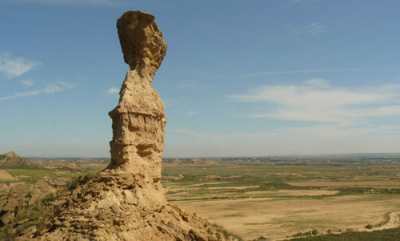Los Monegros Desert
This arid area of Spain is found across Huesca and Zaragoza provinces.
The arid, semi-desert landscape of Los Monegros is the Aragón region’s steppe lands, a vast area in the east of Aragón which straddles the provinces of Huesca and Zaragoza. The ‘comarca’, or district, of Los Monegros covers an area of more than 2,500 square kilometres, but is sparsely populated with a population density of just 7.8 inhabitants per square kilometre.
It’s also one of the driest areas in Spain.

Photo - losmonegros.com
The landscape here is considered unique in Europe, with its hills, plains, gullies and ravines, and the wide open spaces which are dotted with saltwater and freshwater pools and lagoons. Strange rock formations are the result of intensive erosion through the harsh climate.
It was once a densely wooded area, giving rise to the original name, ‘Montes Negros’ – ‘Black Hills’.
It’s an area which is rich in biological diversity, with around 4,500 recorded species. A large lagoon in Sariñena, the district capital, is particularly important for birdlife and is the winter destination for some 12,000 birds. Species seen here include geese, teals, cormorants, egrets, herons, the great crested grebe and the lapwing.
The Sierra de Alcubierre is the most heavily wooded area of Los Monegros and is an important nesting site for birds of prey. It was in these mountains that the writer George Orwell spent two months in early 1937 fighting for the Republicans on the Alcubierre front in the Spanish Civil War.
Los Monegros was the birthplace of Miguel Servet, the scientist and theologian who first described the function of pulmonary circulation and was burnt at the stake as a heretic in 1553. The house where he was born in Villanueva de Sigena is now a museum and is the headquarters of the Michael Servetus Institute which was founded in 1976 to study his life and works.
Also worth a visit is the monastery on the outskirts of the village, on the banks of the Alcanadre River. The Monastery of Santa María de Sigena was founded in 1188 by Doña Sancha, wife of Alfonso II of Aragón and was declared a National Monument in 1923.
The small village of La Cartuja de Monegros, which is administered by Sigena, is home to a 16th Century Carthusian monastery where 18th Century murals painted by Goya’s brother-in-law, Manuel Bayeu, can be seen.
Los Monegros has another claim to fame: it was chosen in 2007 as the site for the ‘Gran Scala’ project, a plan to build the largest gaming and leisure complex in Europe. The massive complex was set to cover 2,000 hectares of land and provide 65,000 new jobs. It was hoped that construction would commence in 2008, but in the end in October 2012 the project was revealed to be a fraud.
